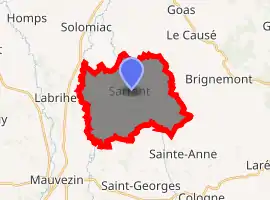Sarrant
Sarrant is a commune in the Gers department in southwestern France.
Sarrant | |
|---|---|
 The church in Sarrant | |
.svg.png.webp) Coat of arms | |
Location of Sarrant 
| |
 Sarrant  Sarrant | |
| Coordinates: 43°46′31″N 0°55′48″E | |
| Country | France |
| Region | Occitanie |
| Department | Gers |
| Arrondissement | Condom |
| Canton | Gimone-Arrats |
| Intercommunality | Bastides du Val d'Arrats |
| Government | |
| • Mayor (2008–2014) | Lucien Calestroupat |
| Area 1 | 19.81 km2 (7.65 sq mi) |
| Population (2017-01-01)[1] | 368 |
| • Density | 19/km2 (48/sq mi) |
| Time zone | UTC+01:00 (CET) |
| • Summer (DST) | UTC+02:00 (CEST) |
| INSEE/Postal code | 32416 /32120 |
| Elevation | 115–192 m (377–630 ft) (avg. 130 m or 430 ft) |
| 1 French Land Register data, which excludes lakes, ponds, glaciers > 1 km2 (0.386 sq mi or 247 acres) and river estuaries. | |
Geography

History
The Philip IV of France (1268 –1314), better known as the Fair or Iron King, set up a charter of customs, which protected the inhabitants and set the living rules in the village community. The charter dated 1265, specified the rights and duties of the residents and the co-lords.[2] According to the charter, consuls headed the royal castrum (fortified camp, rectangular in plan) of Sarrant and not the local Lords.
Structure
The houses of Sarrant create a ring around the central church of the village. This is not a common layout for a Bastide, because in general they were commercial enterprises and the market square was the central element of the village.[3] There are many medieval and half-timbered houses in this village.
Population
| Year | Pop. | ±% |
|---|---|---|
| 1968 | 357 | — |
| 1975 | 319 | −10.6% |
| 1982 | 312 | −2.2% |
| 1990 | 319 | +2.2% |
| 1999 | 338 | +6.0% |
| 2007 | 337 | −0.3% |
| 2012 | 399 | +18.4% |
| 2017 | 368 | −7.8% |
| Source: INSEE[4] | ||
See also
References
| Wikimedia Commons has media related to Sarrant. |
- "Populations légales 2017". INSEE. Retrieved 6 January 2020.
- "Histoire du village". Sarrant - Gers (in French). 29 July 2008. Retrieved 20 June 2016.
- "An Introduction to Bastides (PPT), at About The Bastides". John Reps Collection. Cornell University Library. Retrieved 14 June 2016.
- Population en historique depuis 1968, INSEE